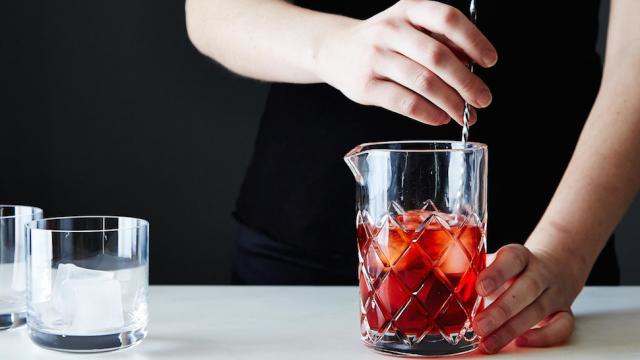You might think that it doesn’t really matter whether a cocktail should be shake or stirred, but there’s actually a huge difference between the two — and the way your drink tastes can change drastically depending on whether or not that martini is shaken or stirred. Here’s how to know when to grab a shaker, and when you need a bar spoon.
It turns out that James Bond wasn’t quite right when he ordered his martinis “shaken, not stirred”. Shaking a cocktail is really only necessary when you need to do a few things: bruise ingredients and break up ice in order to release oils or flavours, or aerate the cocktail for a foamy, frothy or emulsified texture. If your cocktail is mostly spirits — a la a martini, negroni, or old fashioned — there’s no point in getting all of that air into your drink, and doing so can ruin the silky smooth texture anyway. You’re better off stirring.
Here’s how Food52‘s Erik Lombardo explains it:
A great rule of thumb that will rarely ever steer you wrong is this: Stir spirits. That is, if your cocktail is all liquor, stir it. This includes the martini, Manhattan, old fashioned, negroni, and all of their variations. The technical reason for this is simple: They all contain alcohol and have relatively similar densities. They can be incorporated very efficiently by just stirring them together, and if you mix Campari, vermouth, and gin in a glass and let it sit for a week, every part of that mixture will be an undiluted negroni.
…Despite popular belief, shaking doesn’t get cocktails colder — as long as you’re taking the time to stir correctly. Stirring will yield an icy, dense, and silky cocktail, while shaking will yield a frothy, light, and crisp cocktail.
The major difference between shaking and stirring is texture, and the reason the textures differ so much is because of the ingredient that you add while shaking that you don’t add while stirring: air. Shaking, if you’re doing it right, is a violent and dynamic process. The ice cubes are shattering into minuscule shards and adding tiny bubbles to your drink while slamming back and forth in the shaker. This is extremely important when you’re using citrus as an ingredient in your cocktail, because without the lightness that shaking imparts to the drink, the acidity of the citrus can be unpleasant and intense instead of light and refreshing. And citrus juice and alcohol are very different densities, which means they don’t mix easily. (If you mixed gin, lemon juice, sugar syrup, and club soda together and left it for a week, you wouldn’t walk back to find a Tom Collins — you’d find a boozy mixture sitting on top of suspended pulp.)
If you didn’t catch that, the bottom line is shake for citrus, herbs and egg whites. Stir for spirits. Lombardo also explains how the ice plays a role in your drink as well — as in when you want to use a chilled glass, when you want to remove the ice, and when you’ll want ice of varying sizes, even — which you can easily get with a few cubes and a bar spoon. Hit the link below for more.
When to Shake or Stir a Cocktail [Food52]

Comments
One response to “When To Shake And When To Stir A Cocktail”
It’s not that James isn’t right, it’s just that he’s ordering a Bradford. To each his own.
Then again, he usually orders vodka martinis (known as Kangaroos) which is something I’m not a massive fan of.